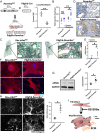The circadian clock protein REVERBα inhibits pulmonary fibrosis development
- PMID: 31879343
- PMCID: PMC6969503
- DOI: 10.1073/pnas.1912109117
The circadian clock protein REVERBα inhibits pulmonary fibrosis development
Abstract
Pulmonary inflammatory responses lie under circadian control; however, the importance of circadian mechanisms in the underlying fibrotic phenotype is not understood. Here, we identify a striking change to these mechanisms resulting in a gain of amplitude and lack of synchrony within pulmonary fibrotic tissue. These changes result from an infiltration of mesenchymal cells, an important cell type in the pathogenesis of pulmonary fibrosis. Mutation of the core clock protein REVERBα in these cells exacerbated the development of bleomycin-induced fibrosis, whereas mutation of REVERBα in club or myeloid cells had no effect on the bleomycin phenotype. Knockdown of REVERBα revealed regulation of the little-understood transcription factor TBPL1. Both REVERBα and TBPL1 altered integrinβ1 focal-adhesion formation, resulting in increased myofibroblast activation. The translational importance of our findings was established through analysis of 2 human cohorts. In the UK Biobank, circadian strain markers (sleep length, chronotype, and shift work) are associated with pulmonary fibrosis, making them risk factors. In a separate cohort, REVERBα expression was increased in human idiopathic pulmonary fibrosis (IPF) lung tissue. Pharmacological targeting of REVERBα inhibited myofibroblast activation in IPF fibroblasts and collagen secretion in organotypic cultures from IPF patients, thus suggesting that targeting of REVERBα could be a viable therapeutic approach.
Keywords: Reverb alpha; circadian; integrin; pulmonary fibrosis; sleep.
Copyright © 2020 the Author(s). Published by PNAS.
Conflict of interest statement
The authors declare no competing interest.
Figures





Comment in
-
The pulse of fibroblasts: circadian rhythm in pulmonary fibrosis development.Cardiovasc Res. 2020 Sep 1;116(11):e134-e135. doi: 10.1093/cvr/cvaa236. Cardiovasc Res. 2020. PMID: 32845965 No abstract available.
References
Publication types
MeSH terms
Substances
Grants and funding
- MR/P023541/1/MRC_/Medical Research Council/United Kingdom
- MR/T032529/1/MRC_/Medical Research Council/United Kingdom
- 107851/Z/15/Z/WT_/Wellcome Trust/United Kingdom
- MR/N002024/1/MRC_/Medical Research Council/United Kingdom
- CIHR/Canada
- 20629/VAC_/Versus Arthritis/United Kingdom
- MR/M008908/1/MRC_/Medical Research Council/United Kingdom
- MR/R023026/1/MRC_/Medical Research Council/United Kingdom
- MR/L006499/1/MRC_/Medical Research Council/United Kingdom
- 103749/WT_/Wellcome Trust/United Kingdom
- 107849/A/15/Z/WT_/Wellcome Trust/United Kingdom
- MR/P023576/2/MRC_/Medical Research Council/United Kingdom
- MR/P011853/2/MRC_/Medical Research Council/United Kingdom
- MR/P023576/1/MRC_/Medical Research Council/United Kingdom
- DH_/Department of Health/United Kingdom
- MR/P011853/1/MRC_/Medical Research Council/United Kingdom
- WT_/Wellcome Trust/United Kingdom
LinkOut - more resources
Full Text Sources
Medical
Molecular Biology Databases

